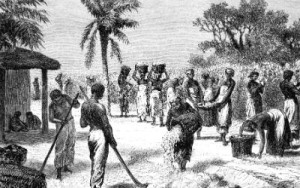100 Amazing Facts About the Negro: You might think you know, but you’re probably wrong.
No. 1: How many Africans were taken to the United States during the entire history of the slave trade?
 Perhaps you, like me, were raised essentially to think of the slave experience primarily in terms of our black ancestors here in the United States. In other words, slavery was primarily about us, right, from Crispus Attucks and Phillis Wheatley, Benjamin Banneker and Richard Allen, all the way to Harriet Tubman, Sojourner Truth and Frederick Douglass. Think of this as an instance of what we might think of as African-American exceptionalism. (In other words, if it’s in “the black Experience,” it’s got to be about black Americans.) Well, think again…
Perhaps you, like me, were raised essentially to think of the slave experience primarily in terms of our black ancestors here in the United States. In other words, slavery was primarily about us, right, from Crispus Attucks and Phillis Wheatley, Benjamin Banneker and Richard Allen, all the way to Harriet Tubman, Sojourner Truth and Frederick Douglass. Think of this as an instance of what we might think of as African-American exceptionalism. (In other words, if it’s in “the black Experience,” it’s got to be about black Americans.) Well, think again…
The most comprehensive analysis of shipping records over the course of the slave trade is the Trans-Atlantic Slave Trade Database, edited by professors David Eltis and David Richardson. (While the editors are careful to say that all of their figures are estimates, I believe that they are the best estimates that we have, the proverbial “gold standard” in the field of the study of the slave trade.) Between 1525 and 1866, in the entire history of the slave trade to the New World, according to the Trans-Atlantic Slave Trade Database, 12.5 million Africans were shipped to the New World. 10.7 million survived the dreaded Middle Passage, disembarking in North America, the Caribbean and South America.
And how many of these 10.7 million Africans were shipped directly to North America? Only about 388,000. That’s right: a tiny percentage.
In fact, the overwhelming percentage of the African slaves were shipped directly to the Caribbean and South America; Brazil received 4.86 million Africans alone! Some scholars estimate that another 60,000 to 70,000 Africans ended up in the United States after touching down in the Caribbean first, so that would bring the total to approximately 450,000 Africans who arrived in the United States over the course of the slave trade.
Incredibly, most of the 42 million members of the African-American community descend from this tiny group of less than half a million Africans. And I, for one, find this amazing.
By the way, how did historian Joel A. Rogers – writer of the 1934 book 100 Amazing Facts About the Negro With Complete Proof, and to whom this column is an homage – do on this question? Well, incredibly, in his “Amazing Fact #30,” Rogers says, “About 12,000,000 Negroes were brought to the New World!” Not even W.E.B. Du Bois got this close to the most accurate count of the number of Africans shipped across the Atlantic in the slave trade.
~ Addendum ~
Fact: Slavery was practiced on a world-wide basis.
Fact: Slavery was practiced for all recorded history.
Fact: The ratification of the US Constitution set a date for the ending of the import of slaves.
Fact: Less than .005% of the imported slaves were not previously enslaved already in Africa prior to transport. Slavery was practiced throughout Africa.
Fact: Nearly every single slave in the Americas, (North, South, Central and Caribbean) were already enslaved in Africa.
Fact: The United States were minor players in the slave trade.
Fact: Citizens of African descent owned slaves in the US.
Fact: The first legal (as determined by a court) slave owner in the English colonies was African.
Fact: The rise in population in slavery in the US had to do with temperate climate and better working conditions than the slaves in South America and the Caribbean.
Fact: The main catalyst to end to slavery came about from Christian societies and usually all-white churches.
Fact: Most of the slaves were enslaved in Africa as punishment for crimes 30%, settlement of debts 35% (it was okay to sell your children, wives or even nieces and nephews) and raids on nearby villages and wars, roughly 35%.
Fact: The slaves that remained in Africa, more often than not, were killed after the harvesting seasons. The tribes didn’t want to have to feed extra mouths if not necessary.
Of course, the Pyramids were built by an all-volunteer work-force. They just posted on Craig’s list and paid them a living wage.
Written by Henry Louis Gates Jr. for The Root ~ January 6, 2014.
Henry Louis Gates Jr. is the Alphonse Fletcher University Professor and founding director of the Hutchins Center for African and African American Research at Harvard University. He is also editor-in-chief of The Root. Follow him on Twitter and Facebook.
FAIR USE NOTICE: This site contains copyrighted material the use of which has not always been specifically authorized by the copyright owner. We are making such material available in our efforts to advance understanding of environmental, political, human rights, economic, democracy, scientific, and social justice issues, etc. We believe this constitutes a ‘fair use’ of any such copyrighted material as provided for in section 107 of the US Copyright Law. In accordance with Title 17 U. S. C. Section 107, the material on this site is distributed without profit to those who have expressed a prior interest in receiving the included information for research and educational purposes. For more information go to: http://www.law.cornell.edu/uscode/17/107.shtml
